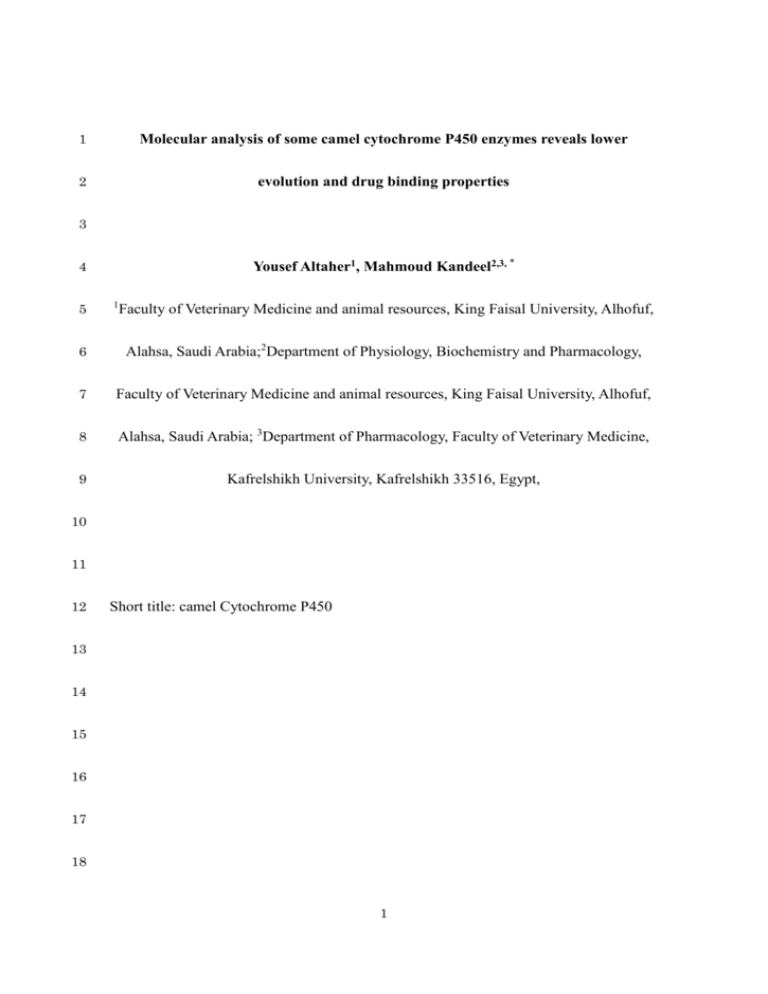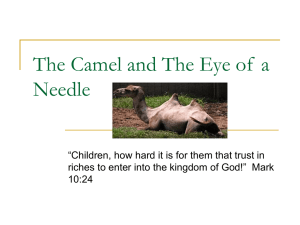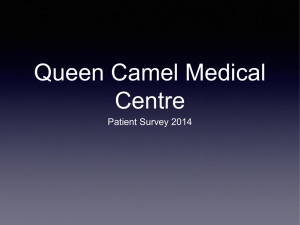- Figshare
advertisement

1 Molecular analysis of some camel cytochrome P450 enzymes reveals lower 2 evolution and drug binding properties 3 4 5 Yousef Altaher1, Mahmoud Kandeel2,3, * 1 Faculty of Veterinary Medicine and animal resources, King Faisal University, Alhofuf, 6 Alahsa, Saudi Arabia;2Department of Physiology, Biochemistry and Pharmacology, 7 Faculty of Veterinary Medicine and animal resources, King Faisal University, Alhofuf, 8 Alahsa, Saudi Arabia; 3Department of Pharmacology, Faculty of Veterinary Medicine, 9 Kafrelshikh University, Kafrelshikh 33516, Egypt, 10 11 12 Short title: camel Cytochrome P450 13 14 15 16 17 18 1 1 Abstract 2 Camels bear unique genotypes and phenotypes for adaptation of their harsh 3 environment. They have unique visual systems, sniffing, water metabolism, heat control 4 mechanisms that are different from other creatures. The recent announcement for the 5 complete sequence of camel genome will allow for discovery of many secrets of camel 6 life. In this context, the genetic bases of camel drug metabolizing enzymes are still 7 unknown. Furthermore, the genomic content of camel that rendered it highly susceptible 8 to some drug (as monensin and salinomycin) and became easily intoxicated needs to be 9 investigated. The objectives of this work are annotation of camel genome and retrieval 10 of camel for cytochrome P450 1A1, 2C and 3A enzymes. This is followed by 11 comprehensive phyolgentic, evolution, molecular modeling and docking studies. In 12 comparison with the human enzymes, camel CYPs showed lower evolution rate 13 especially 14 alfanaphthoflavone, felodepine and ritonavir was weaker in camel enzymes. 15 Interestingly, rerank score indicated instable binding of monensin and salinomycin with 16 camel CYP1A1 as well as salinomycin with camel CYP2C. The results of this work 17 suggest that camels are more susceptible to toxicity with compounds undergoing 18 metabolic oxidation. This conclusion was based on lower evolution rate and lower 19 binding potency of camel s compared with the human enzymes. CYP1A1. Furthermore, the binding of monensin, 20 21 Keywords 22 Camel, cytochrome P450, phylogenetics, docking, molecular modeling 23 2 salinomycin, 1 Introduction 2 Camels are reared in arid and semi-arid harsh environment. In order to adapt such 3 habitat, camels developed unique molecular pathways including rapid evolution or 4 regression of some genes, new genotypes and phenotypes. In this regard, camels 5 developed unique pathways to cope with their surrounding environment. For instance, 6 camels can withstand deprivation of water, heat and dryness for long time. This is 7 accompanied by complex regulation processes, which control water metabolism and 8 whole body metabolic processes. Thermographic tracing of camels body temperature 9 reveals daily changes in body temperature across the day and night in a temperature 10 range from 34-41°C. The maximal and minimal temperatures are within the afternoon 11 and early morning, respectively. Therefore, the flow of heat to the body of camels from 12 the surrounding desert is minimized and water loss by perspiration is reduced. 13 Interestingly, camels has high sweating threshold, in which camels start sweating when 14 their body temperature exceeds 42°C (Kohler-Rollefson, 1993). Camels mitochondrial 15 enzymes are characterized by high evolution rate and contribute to the adaptation of 16 camels to live in different environments (Di Rocco et al., 2006; Di Rocco et al., 2009). 17 Camels are raised for production of wool, milk, leather and meat. Additionally, it is used 18 in transportation and management of agricultural crops in arid and semiarid regions. 3 1 Increased interest in camels rearing is increasing nowadays for human nutrition and 2 production of modern therapeutics. Camels nanobodies derived from the unique camel 3 single domain antibodies are new interesting class of therapeutic and diagnostic 4 reagents (Badr, 2013; Fraile et al., 2013; Korish, 2014; Unciti-Broceta et al., 2013). 5 Camels are intoxicated with several drugs, which seems to be used safely in other 6 animals (Ali, 1988; Alquarawi and Ali, 2000; el Bahri et al., 1999; Mousa and Elsheikh, 7 1992). For instance, camels cannot tolerate ionophores as monensin, and salinomycin 8 (Abu Damir et al., 2013; Miller et al., 1990; Mousa and Elsheikh, 1992). In comparison, 9 these compounds (Fig. 1) are well tolerated in other animals as poultry, sheep and cattle. 10 These ionophores are used in veterinary practice for prophylaxis against protozoal 11 diseases, growth promotion and antibacterial effect. For comparison, monensin at dose 12 rate of 0.6 mg/kg is lethal for camels, while chicken can resist up to 50 mg/kg. In 13 another example, diminazine aceturate was found to be more toxic in camels than other 14 species (Homeida et al., 1981). 15 The full sequence of camels genome has been published (Wu et al., 2014). The 16 discovery of camel genome sequence will help in resolving the secrets of camel’s 17 molecular processes and mechanisms of adaptation. In this context, the nature of drug 18 metabolism and its associated camel genetic background is not investigated. It is not 4 1 known whether camel cytochrome P450 enzymes are specifically evoluted or adapted 2 for desert life. This study investigates three camel cytochrome P450 enzymes (CYP), 3 CYP1A1, CYP2C and CYP3A. This work will be the first investigation of camel 4 genome sequence and its pharmacogenomic implications. Cytochrome P450 enzymes 5 are the major drug metabolizing enzymes by performing more than 80% of the 6 metabolic functions. The metabolism of monensin was found to be mainly by CYP 7 oxidation (Nebbia et al., 1999; Nebbia et al., 2001). In this study, we show the lower 8 evolution rate and suboptimal drug binding capacity of camel CYPs compared with the 9 human enzymes. This might suggest the reason beyond camel toxicity with these 10 compounds. 11 12 Methods 13 1- Annotation of camel genome 14 Genomic 15 (http://tritrypdb.org/tritrypdb/), 16 (http://www.ncbi.nlm.nih.gov) 17 (http://www.camel.kacst.edu.sa). Inspection and analysis of ESTs was carried out by 18 CLC genomics workbench version 7.5.1. About 17155 contigs were retrieved and kept 19 as local BLAST database. data are extracted from the protein and Kinetoplastom and the 20 5 Arabian genome camel genome resources databases genome at project 1 2- Retrieval of camel CYP1A1, CYP2C and CYP3A enzymes 2 The sequences of genes encoding CYP1A1, CYP2C and CYP3A were searched in 3 nucleotide databases and the human, Camelus ferus and Camelus bactrianus sequences 4 are saved. The retrieved sequences are used to BLAST the local database of camel ESTs 5 library to retrieve the hits of highest similarity. The retrieved E values were as from 6 1.16 E-130 to zero. The obtained contigs were retrieved and subjected for further 7 molecular modeling and phylogenetic studies. 8 We tried to do the above mentioned procedure for CYP4A enzyme. However, we were 9 unable to find any hits with sufficient E value. So that we excluded CYP4A from 10 further investigations. We ran another EST assembly run by using CLC genomics 11 workbench De Novo assembly from which we retrieved new 2466 contigs. 12 Unfortunately, BLAST search with human CYP4 sequence did not came back with 13 significant similarities. 14 15 3- BLAST search and sequence alignment 16 The retrieved camel sequences were used to BLAST non-redundant nucleotides 17 databases at NCBI. All organisms are searched with expect value of 10. The top 100 18 hits with the lowest E value were downloaded and kept in one batch file for sequence 19 alignment. Sequence alignment was set to very accurate. 20 21 4- Phylogenetic and evolutionary analysis 22 In order to evaluate the evolution rate of camel enzymes we used Bayesian evolutionary 23 analysis under relaxed phylogenetic models by using BEAST (Bayesian Evolutionary 24 Analysis Sampling Tree) software package version 2.1.3 (Drummond and Rambaut, 6 1 2007; Drummond et al., 2012). The nucleotide sequences from different hits were 2 exported in NEXUS format by using geneious 7.1.7 software package. The BEAUti 3 software was used to convert NEXUS file to xml format for Bayesian evolutionary 4 analysis. Substitution rate was set for 1, gamma category count was set to 4 and the 5 JC69 was used as a substitution model. Timing data were not provided and the branch 6 lengths represented the substitutions per year with an assumed average of 1. Relaxed 7 clock log normal was set for clock model at clock rate of 1 and uniform birth rate. 8 Marcov Chain Monte Carlo (MCMC) mathematical model is used by BEAST, the 9 length of chain was set to 1000000 and the log file is saved for tree annotation by 10 TreeAnnotator software. The produced tree is visualized and annotated by FigTree 11 software. Examination of MCMC results were viewed by Tracer program. 12 13 5- Molecular modeling studies 14 Requests for building molecular models for the camel enzymes were submitted to 15 SWISS Model server. Models of camel CYPs were built on their corresponding human 16 enzymes templates in automated mode of SWISS Model server. The used human CYPs 17 templates were PDB ID no. 4I8V, 2NNJ and 4NXU. The obtained structure models 18 were checked, minimized, water removed and prepared for docking studies (Fig. 2). 19 20 6- Molecular docking studies 21 Molecular docking studies were carried out by Molegro virtual docker. Monensin and 22 salinomycin were selected for comparative docking studies (Fig. 1). Furthermore, each 23 derived human PDB template contains a drug bound to its active site. These drugs are 24 alfa naphthflavone, felodepine and ritonavir for 4I8V, 2NNJ and 4NXU, respectively. 7 1 These compounds were also used for docking of both camel and human enzymes. The 2 accuracy of docking run was evaluated by comparison of the docked poses with the 3 conformation of compounds in their sites of crystal structures. 4 For preparation of compounds for docking, SDF files were exported from PubChem 5 database. The energy was minimized and conformationally optimized by Chem3D Pro, 6 Cambridge soft and saved as MDL MOL files. Docking site was based on template 7 docking after concluding the forces of interaction. For camel enzymes, the docking site 8 was assigned from the respective human interactions. The docking session was 9 performed for 10 runs for each compound under 1500 maximal iterations per 10 compound. 11 12 Results 13 Sequence alignment 14 Sequence alignments of human and camel CYP1A1, CYP2C and CYP3A are shown in 15 Fig. 2. The alignment results indicate high similarity during within the same CYP 16 family and low similarity among different families. The similarity of human and camel 17 enzymes within CYP1A1, CYP2C and CYP3A were 82.7, 68.7 and 75%, respectively. 18 In contrast, comparison of camel CYP enzymes with each other or human CYP enzymes 19 with each other gives low similarity, range from 20-31%. 20 21 Docking studies 8 1 The selected docking output included hydrogen bonding, MolDock score and rerank 2 score. MolDock score is the default output of docking energy. Rerank score is used to 3 assess the stability of binding. Following docking run, rerank of the output poses is 4 performed. Rerank score is a modification of docking score with considerations of steric 5 hindrance. Thus, rerank score is more computationally valuable than the docking score. 6 For CYP1A1, zero value of hydrogen bonding of naphthoflavone indicates the general 7 capacity of CYP1A1 to bind and metabolize substrates. The negative value of MolDock 8 score indicates the potential binding of all drugs to human and camel CYP1A1. 9 However, rerank score values indicates instability of binding salinomycin with human 10 CYP1A1 and instable binding of monensin and salinomycin with camel CYP1A1 11 (Table 1). 12 For CYP2C, all compounds showed favourable and stable binding with both human and 13 camel enzymes except salinomycin which is expected to form unstable complexes with 14 the camel enzyme (Table 2). All compounds were found to bind to CYP3A with 15 potential stability. 16 For all analyzed enzymes and compounds, results from camel enzymes showed inferior 17 binding potency by showing lower docking and rerank scores in all compounds (Tables 18 1, 2 and 3). 9 1 2 Phylogenetic analysis and gene evolution 3 Phylogenetic analysis of CYP1A1, CYP2C and CYP3A are shown in figures 3, 4 and 5, 4 respectively. The selected phylogenetic parameters are represented in Table 4. For easier 5 identification, several markers are applied for conclusions about gene evolution rates. 6 These include the colours of branches and species, the size of the node or the numbers 7 wrote for each branch. The scale of rate is provided in the top left corner of each figure. 8 Red colour denotes the highest rate. Similarly, the thicker branch line indicates higher 9 rate. The estimated rate of evolution was lower in camel enzymes compared to human 10 enzymes (Table 4). The values of camel CYP2C and CYP3A were almost comparable 11 to average rate determined by Bayesian analysis. Adversely, Camel CYP1A1 showed 12 lower evolution rate. 13 14 Discussion 15 Camels are thought to be evolved several million years ago. They gradually adapted to 16 their surrounding environment by genetic adaptation and phenotype variation. Camels 17 were domesticated about 3000-6000 years ago (Burger and Palmieri, 2014). During 18 domestication, adaptation to the new environment elicited further variations in the 10 1 genetic composition. By the advent of new genome technologies, it became easier to 2 map genetic variations and changes in genes by comparison of domesticated and wild 3 animals. Furthermore, phylogenetic and other computational tools improved the 4 understanding of biological functions, disease control and discovery of drugs (Kandeel 5 et al., 2014; Kandeel and Kitade, 2013a, b). The selection pressure for rapid evolution, 6 slow evolution or loss of certain gene can be analyzed and compared between the 7 Arabian camel and wild camels. Understanding these changes highlight the 8 physiological status of animals, their response to drugs and potential success or failure 9 of treatment. 10 Clinical and experimental practice with camel diseases revealed that camels are resistant 11 to toxicity of some compounds and were also very susceptible to toxicity of other drugs. 12 In this work, some drug metabolizing enzymes (CYP1A1, CYP2C and CYP3A) in 13 camels are investigated to reveal their role in susceptibility or resistance of camels to 14 drug toxicity. Furthermore, phylogenic approaches are undertaken to assess the 15 evolution rates of camel enzymes. 16 Phylogenetic analysis revealed a lower rate of evolution of camel enzymes compared 17 with that of human cytochromes. Camel CYP2C and CYP3A did not show major 18 changes compared with the tested dataset. In contrast, CYP1A1 showed considerably 11 1 low rate of evolution. In this regards, camel CYP1A1 docking data revealed instable or 2 potential lack of binding with monensin and salinomycin. In parallel with the 3 phylogenetics analysis, docking data also confirmed lower efficiency of camel 4 cytochrome enzymes in binding different drugs compared with the human enzymes. 5 Lower rate of evolution of camel enzymes, lower binding with different drugs and 6 instability of binding of some drugs highlights the potential susceptibility of camels to 7 toxicity with drugs. Monensin and salinomycin, which are highly fatal to camels might 8 have lower binding capacity to the camel enzymes allowing for toxicity. Both monensin 9 and salinomycin were bound effectively by camel CYP3A but not with CYP1A1 and 10 CYP2C indicating that CYP3A might be the major metabolizing enzyme for these drugs 11 in camel. Similar experimental finding was previously described in cattle, chicken and 12 rats (Nebbia et al., 1999). As described above the binding potency of monensin with 13 camel enzymes is lower than that of human indicating more potential toxicity to camels 14 due to slower metabolism. 15 16 Acknowledgements 17 This work is supported by grants for undergraduate students projects to Mahmoud 18 Kandeel and Yousef Altaher (grant number 165033) from the deanship of scientific 12 1 research, King Faisal University, Hofuf, Alahsa, Saudi Arabia. 2 3 References 4 Abu Damir, H., Ali, M.A., Abbas, T., Omer, E., Al Fihail, A., 2013. Narasin poisoning in the dromedary camel (Camelus dromedarius). Comparative Clinical Pathology, 1-7. Ali, B.H., 1988. A survey of some drugs commonly used in the camel. Vet Res Commun 5 6 7 8 9 10 11 12 13 14 15 16 17 18 19 20 21 22 23 24 25 26 27 28 29 30 31 32 33 12, 67-75. Alquarawi, A.A., Ali, B.H., 2000. A survey of the literature (1995-1999) on the kinetics of drugs in camels (Camelus dromedarius). Vet Res Commun 24, 245-260. Badr, G., 2013. Camel whey protein enhances diabetic wound healing in a streptozotocin-induced diabetic mouse model: the critical role of beta-Defensin-1, -2 and -3. Lipids Health Dis 12, 46. Burger, P.A., Palmieri, N., 2014. Estimating the Population Mutation Rate from a de novo Assembled Bactrian Camel Genome and Cross-Species Comparison with Dromedary ESTs. J Hered 105, 839-846. Di Rocco, F., Parisi, G., Zambelli, A., Vida-Rioja, L., 2006. Rapid evolution of cytochrome c oxidase subunit II in camelids (Tylopoda, Camelidae). J Bioenerg Biomembr 38, 293-297. Di Rocco, F., Zambelli, A.D., Vidal Rioja, L.B., 2009. Identification of camelid specific residues in mitochondrial ATP synthase subunits. J Bioenerg Biomembr 41, 223-228. Drummond, A.J., Rambaut, A., 2007. BEAST: Bayesian evolutionary analysis by sampling trees. BMC evolutionary biology 7, 214. Drummond, A.J., Suchard, M.A., Xie, D., Rambaut, A., 2012. Bayesian phylogenetics with BEAUti and the BEAST 1.7. Mol Biol Evol 29, 1969-1973. el Bahri, L., Souilem, O., Djegham, M., Belguith, J., 1999. Toxicity and adverse reactions to some drugs in dromedary (Camelus dromedarius). Vet Hum Toxicol 41, 35-38. Fraile, S., Jimenez, J.I., Gutierrez, C., de Lorenzo, V., 2013. NanoPad: an integrated platform for bacterial production of camel nanobodies aimed at detecting environmental biomarkers. Proteomics 13, 2766-2775. Homeida, A.M., El Amin, E.A., Adam, S.E., Mahmoud, M.M., 1981. Toxicity of diminazene aceturate (Berenil) to camels. J Comp Pathol 91, 355-360. Kandeel, M., Al-Taher, A., Nakashima, R., Sakaguchi, T., Kandeel, A., Nagaya, Y., 13 1 2 3 4 5 6 7 8 9 10 11 12 13 14 15 16 17 18 19 20 21 22 23 24 25 26 27 28 29 30 31 32 33 34 35 36 Kitamura, Y., Kitade, Y., 2014. Bioenergetics and Gene Silencing Approaches for Unraveling Nucleotide Recognition by the Human EIF2C2/Ago2 PAZ Domain. PLoS One 9, e94538. Kandeel, M., Kitade, Y., 2013a. Computational analysis of siRNA recognition by the Ago2 PAZ domain and identification of the determinants of RNA-induced gene silencing. PLoS One 8, e57140. Kandeel, M., Kitade, Y., 2013b. In silico molecular docking analysis of the human Argonaute 2 PAZ domain reveals insights into RNA interference. Journal of computer-aided molecular design 27, 605-614. Kohler-Rollefson, I., 1993. About camel breeds: A reevaluation of current classification systems. J Anim Breed Genet 110, 66-73. Korish, A.A., 2014. The antidiabetic action of camel milk in experimental type 2 diabetes mellitus: an overview on the changes in incretin hormones, insulin resistance, and inflammatory cytokines. Horm Metab Res 46, 404-411. Miller, R.E., Boever, W.J., Junge, R.E., Thornburg, L.P., Raisbeck, M.F., 1990. Acute monensin toxicosis in Stone sheep (Ovis dalli stonei), blesbok (Damaliscus dorcus phillipsi), and a Bactrian camel (Camelus bactrianus). J Am Vet Med Assoc 196, 131-134. Mousa, H.M., Elsheikh, H.A., 1992. Monensin poisoning in dromedary camels. Dtsch Tierarztl Wochenschr 99, 464. Nebbia, C., Ceppa, L., Dacasto, M., Carletti, M., Nachtmann, C., 1999. Oxidative metabolism of monensin in rat liver microsomes and interactions with tiamulin and other chemotherapeutic agents: evidence for the involvement of cytochrome P-450 3A subfamily. Drug Metab Dispos 27, 1039-1044. Nebbia, C., Ceppa, L., Dacasto, M., Nachtmann, C., Carletti, M., 2001. Oxidative monensin metabolism and cytochrome P450 3A content and functions in liver microsomes from horses, pigs, broiler chicks, cattle and rats. J Vet Pharmacol Ther 24, 399-403. Unciti-Broceta, J.D., Del Castillo, T., Soriano, M., Magez, S., Garcia-Salcedo, J.A., 2013. Novel therapy based on camelid nanobodies. Ther Deliv 4, 1321-1336. Wu, H., Guang, X., Al-Fageeh, M.B., Cao, J., Pan, S., Zhou, H., Zhang, L., Abutarboush, M.H., Xing, Y., Xie, Z., Alshanqeeti, A.S., Zhang, Y., Yao, Q., Al-Shomrani, B.M., Zhang, D., Li, J., Manee, M.M., Yang, Z., Yang, L., Liu, Y., Zhang, J., Altammami, M.A., Wang, S., Yu, L., Zhang, W., Liu, S., Ba, L., Liu, C., Yang, X., Meng, F., Li, L., Li, E., Li, X., Wu, K., Zhang, S., Wang, J., Yin, Y., Yang, H., Al-Swailem, A.M., 2014. Camelid genomes reveal evolution and adaptation to desert environments. Nat Commun 14 1 5, 5188. 2 3 4 5 Table 1: The docking results of docking human and camel CYP1A1 with alfa naphthoflavone, monensin and salinomycin. 6 7 human camel Hydrogen MolDock Rerank bond score score 272.29 0 -106.7 -91.5 monensin 670.87 -6.2 -185.5 -71.6 salinomycin 750.9 -11.5 -152.6 69.25 Alfa naphthflavone 272.29 0 -100 -76.7 monensin 670.87 -10 -160 74.1 salinomycin 750.9 -3.7 -121 106.8 enzyme Compounds MW Cytochrome Alfa naphthoflavone 1 Cytochrome 1 8 9 10 11 15 1 2 3 4 5 Table 2: The docking results of docking human and camel CYP2C with felodepine, monensin and salinomycin. 6 Enzyme human camel Cytochrome 2 Cytochrome 2 Hydrogen MolDock Rerank bond score score Compounds MW felodepine 384 0 -61.2 -17.5 monensin 670.87 -19.1 -134.7 .71.1 salinomycin 750.9 -8.2 -91.6 -91.6 felodepine 384 0 -62.4 -46.2 monensin 670.87 -7.1 -134.6 -27.9 salinomycin 750.9 -2.1 -91.4 61.2 7 8 9 10 11 16 1 2 3 4 Table 3: The docking results of docking human and camel CYP3A with ritonavir, monensin and salinomycin. 5 Enzyme human camel Cytochrome 3 Cytochrome 3 Hydrogen MolDock Rerank bond score score Compounds MW ritonavir 720 -1.5 -154.5 -92.1 monensin 670.87 -2.5 -119.3 -79.8 salinomycin 750.9 -2.3 -126.8 -89.7 ritonavir 720 0 -152.6 -23.4 monensin 670.87 -18.2 -115.5 -35.4 salinomycin 750.9 -1.1 -107 -81.5 6 7 8 9 10 17 1 2 3 Table 4. The parameters of rate obtained by BEAST analysis and Tracer program for CYP1A1, CYP2C and CYP3A 4 Rate mean Rate variance Tree likelihood Camel rate Human rate CYP1A1 0.94 0.5 -7.4 E-4 0.73 1.18 CYP2C 0.97 0.18 -3.1 E-4 1.09 1.62 CYP3A 0.98 0.17 -2.2 E-4 1.04 1.65 5 6 7 8 9 10 11 12 13 14 15 16 18 1 Figure legends 2 Fig. 1. Chemical structure of compounds used in docking studies 3 Fig. 2. Molecular models of camel CYP1A1 bound with alfanaphthoflavone (A), camel 4 CYP2C bound with felodepine (B) and camel CYP3A bound with ritonavir (C). 5 Fig. 3. Sequence alignment of human and camel CYP1A1, CYP2C and CYP3A. The 6 alignment, annotation, and figure was created by Geneious 7.1 software package. 7 Fig. 4. Phylogenetic tree of CYP1A1 8 Fig. 5. Phylogenetic tree of CYP2C 9 Fig. 6. Phylogenetic tree of CYP3A 10 11 12 13 19
![KaraCamelprojectpowerpoint[1]](http://s2.studylib.net/store/data/005412772_1-3c0b5a5d2bb8cf50b8ecc63198ba77bd-300x300.png)








